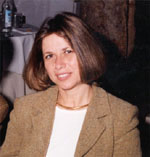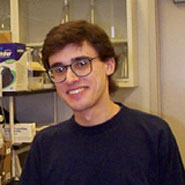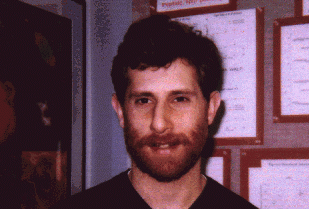|

|
Dr. Ivet Bahar, Dept.
Chair
(Research Lab Page)
(412) 648-3333
|
Chair, Department of Computational Biology, School of Medicine
Modeling and simulations of the structure & dynamics of biomolecular
complexes and assemblies; statistical mechanics of macromolecules;
molecular aspects of biochemical and biophysical networks; computer
modeling and engineering of enzyme-substrate, protein-DNA and
protein-drug binding and interactions; mathematical modeling of cell
cycle signaling and regulation, statistical analysis of gene
expression arrays.
|
|

|
Dr.Takis Benos
(Research Lab Page)
(412) 648-3315
Email
|
Assistant Professor,
Department of Computational Biology, School of Medicine
I am interested in
understanding the mechanisms that determine the DNA-binding
specificity of the transcription factors. My group develops
probabilistic and computational models of the recognition of DNA by
proteins. Among other applications, these methods are used for
the identification of DNA-regulatory regions in a genomic
scale.
|
|

|
Dr. Carlos Camacho
(412) 648-7776
Email
|
Associate Professor,
Department of Computational Biology, School of Medicine
A striking set of specific and non-specific interactions encoded
in the protein structure tolerates binding only to a unique
substrate. My main research interests focus on modeling the physical
interactions responsible for molecular recognition, and in the
development of new technologies for structural prediction, their
substrates and supramolecular assemblies. Any progress in these
fundamental problems is bound to bring about a better understanding
of how proteins work cooperatively in a cell, promoting
breakthroughs in every aspect of the biological sciences.
|
 |
Dr.
Bino John
(412)
648-8607
Email |
Assistant
Professor,
Department of Computational Biology, School of Medicine
The broad
objective of our research is to help cure human diseases by
developing bioinformatics/computational and experimental methods
to study gene functions. Recent studies link non-protein-coding
RNAs to cancer and other diseases. Noncoding RNAs such as
microRNAs are thought to post-transcriptionally regulate a large
number of human genes. The research on non-coding RNAs is likely
to provide new diagnostic and prognostic markers and eventually
therapeutic targets for the treatment of human diseases. We also
aim to develop methods to aid computer aided drug design efforts.
Our research strategy is to apply bioinformatics/computational
methods to formulate reasonable hypotheses about interesting
biological problems and subsequently conduct experiments to test
them.
|
|

|
Dr. Ivan Maly
(412) 648-7771
Email
|
Assistant
Professor,
Department of Computational Biology, School of Medicine
The general direction of my research is theoretical
development, computational analysis, and experimental validation of
quantitative models that explain cellular morphogenesis from the
systems standpoint, integrating molecular motor-driven transport,
cytoskeleton dynamics, and cell signaling.
|
|
|
Dr. Hagai Meirovitch
(Research Lab Page)
(412) 648-3338
Email
|
Professor,
Department of Computational Biology, School of Medicine
Structure and function of proteins by the energetic and statistical
approaches. Development of modeling of solvation, methods for
calculating the entropy and the free energy of macromolecules and
fluids (water), and simulation and conformational search techniques
for protein systems. These methods are components of a new
statistical mechanics methodology for treating flexibility applied
to loops, peptides, and active sites to understand protein-protein
and protein-ligand recognition processes (e.g., antibody-antigen
interactions) and to analyze NMR and x-ray data of flexible
molecules.
|
|
|
Dr. John Vries
412-383-9146
Email
|
Associate Professor,
Department of Computational Biology, School of Medicine
Asymmetry in
the distribution of attributes along biological sequences generates
signals with characteristic frequency and phase spectra. Asymmetry
in the distribution of contacts in 3-dimensional models also
generates signals with characteristic spectra. In some cases, these
spectra are correlated. My research attempts to predict tertiary
structure from these correlations. The long term goal is go develop
an alignment-independent method for protein classification. The
methodologies employed include n-gram analysis, Fourier analysis,
eigenfunction decomposition and all poles spectral density
estimation. In related research, correlations between the
periodicity of pairwise relationships in molecular dynamics
simulations and the results of Gaussian network analysis are
compared.
|
|

|
Dr. Daniel Zuckerman
(412) 648-3335
Email
|
Assistant Professor,
Department of Computational Biology, School of Medicine
I am interested in a variety of computational methods
in bio-molecular-physics and physical chemistry: free energy
calculations (e.g., of binding affinities), determination of
reaction path(s) & rates, and the utility of simple models of
biomacromolecular dynamics. Because current computers -- and those
of the foreseeable future -- are quite slow with respect to many
biologically important calculations, the basic goal is to generate
physical/chemical/biological data more rapidly via new algorithms or
reduced models.
|